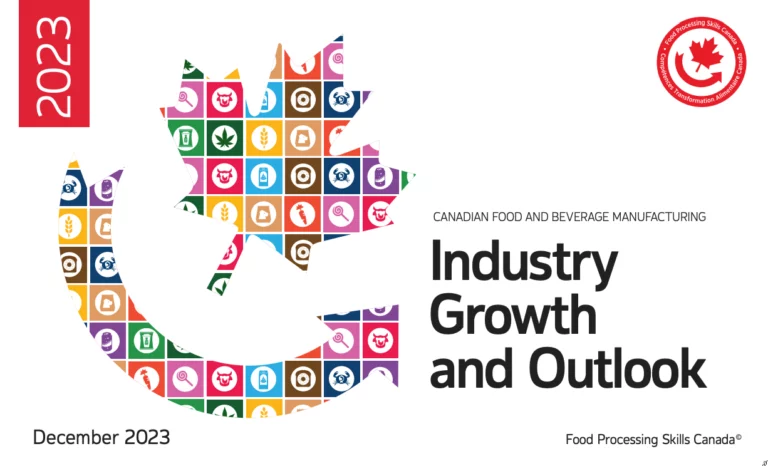
Labour market information is essential to Canadian food and beverage manufacturers in making informed business and workforce decisions. The research conducted by Food Processing Skills Canada (FPSC) provides an important health check on the present situation for the industry and what is expected in the future. The research also guides solutions that support people and businesses.
Recently, FPSC completed a study of current and future employment, hiring requirements, and labour market conditions for the industry. The research also looked specifically at market conditions and labour market challenges for dairy product manufacturing, seafood product preparation and packaging, meat product manufacturing, and bakeries and tortilla manufacturing. The information presented is meant to better inform government, employers and industry stakeholders about the degree and nature of labour market challenges faced by Canada’s Food Processing industry.
"Our research results provide a health check on the present situation for the industry and what is expected in the future."
The food and beverage processing industry generated over $153.6 billion in sales annually as of 2022, with Meat product manufacturing generating more sales than any other subsector. As of 2021, there were approximately 13,150 food and beverage processing establishments in Canada, with the majority of establishments are concentrated in Ontario, Quebec or British Columbia.
The food and beverage processing industry is a significant contributor to the Canadian labour market, employing approximately 300,000 workers in 2022, with most food processing establishments employing less than 100 people.
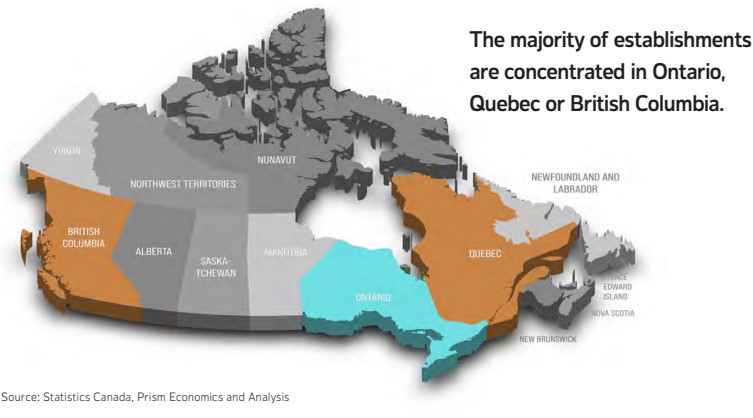
Labour market information is essential to Canadian food and beverage manufacturers in making informed business and workforce research.
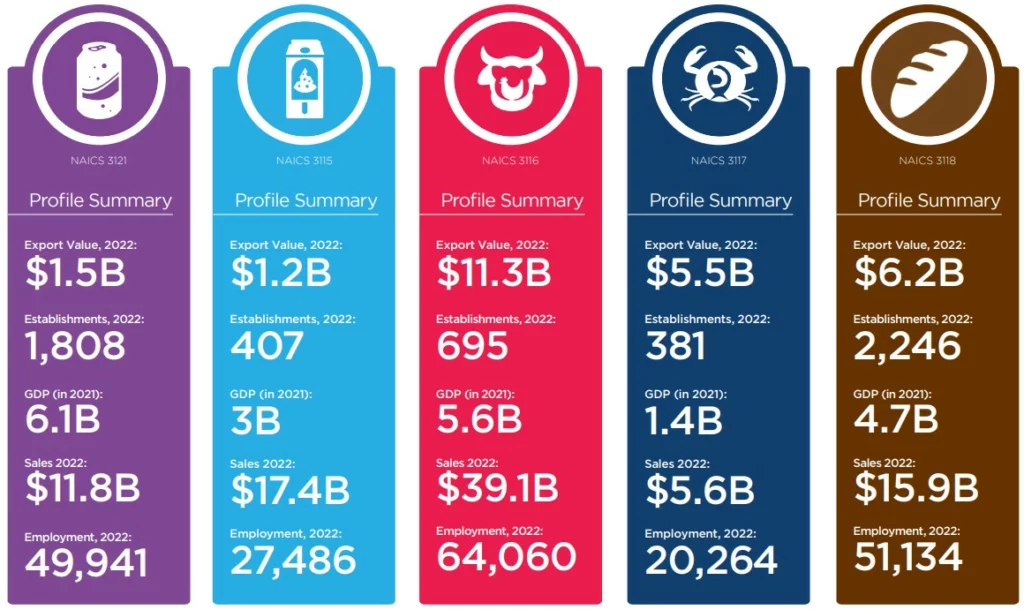

In 2022, Canada’s food and beverage manufacturing industry was made up of approximately 13,150 establishments contributing $35B to Canada’s GDP and directly employing nearly 300,000 people. In the same year, the value of Canadian food and beverage exports was estimated at $54.3B accounting for 7% of Canada’s total exports.
Between 2023 and 2030, the Canadian food and beverage manufacturing industry is estimated to need to hire and retain over 92,500 additional people. The average annual hiring requirement of approximately 11,500 new people per year is driven primarily by the need to replace an estimated 66,800 retirements and age-related exits while considering projected industry growth and labour productivity gains. Additionally, the industry’s current 50,000 vacancies that remain unfilled means the total hiring requirement increases to 142,000 new people or almost 50% of the current workforce.
Beverage manufacturing is projected to lead industry growth, with employment increasing 16% between 2023 and 2030. Bakeries and tortilla manufacturing is also projected to see notable employment growth by 2030 from increased consumption over the decade. Dairy and meat processing, segments which have seen a decline in consumption, are projected to see more modest growth over the same period.
"In total, the Canadian food and beverage manufacturing industry will need 142,000 new people between 2023 and 2030 or almost 50% of the current workforce."
The Food and Beverage Processing industry was not immune to the impacts of the pandemic. The industry was inundated with supply disruptions, rising input costs, heightened demand and tight labour market conditions. Despite these challenges, the industry faired relatively well the through the pandemic and looking ahead, the outlook is strong despite concerns about rising input costs from inflation and workforce availability.
Canadian consumer preferences have been evolving. According to a food consumer survey conducted by Deloitte (2021), consumption of processed foods has been on the decline, a trend that is anticipated to continue with the prevalence of increasingly health-conscious consumers. Additionally, households are cutting back spending due to inflationary pressure and are growing more selective about food spending. These shifts will have significant impacts on the consumption of meat and dairy products, which currently comprise the two largest segments of the market. Canadians are opting for red meat and processed meat alternatives, including plant-based protein options, organic meat, poultry and seafood. Consumers have also reported increased consumption or have indicated an inclination towards plantbased milk, which has ultimately slowed spending in the dairy sector.
Automation and emerging technology present an opportunity for Canadian food and beverage processing manufacturers. Adoption of the latest technology will be necessary for the industry to increase productivity and remain competitive in international markets over the coming decade.

Hiring requirements for the Canadian food and beverage manufacturing industry consider both industry growth and the need to replace workers who have retired or died. Replacement demand (retirements and deaths) will be the driving component for hiring over the 2023 to 2030 period with a total demand of 66,800 new workers to replace the industry’s aging workforce. These demands are accelerated toward the end of the decade as the share of workers nearing retirement age increases.
Accounting for both industry growth and the aging workforce, it is estimated that the industry will need to hire 92,500 workers over the 2023 to 2030 period. This is equivalent to approximately 31% of the 2022 workforce.
When including the current labour vacancies of 50,000 workers, the hiring demand rises to 142,000 new people by 2030 or approximately 50% of today’s workforce.
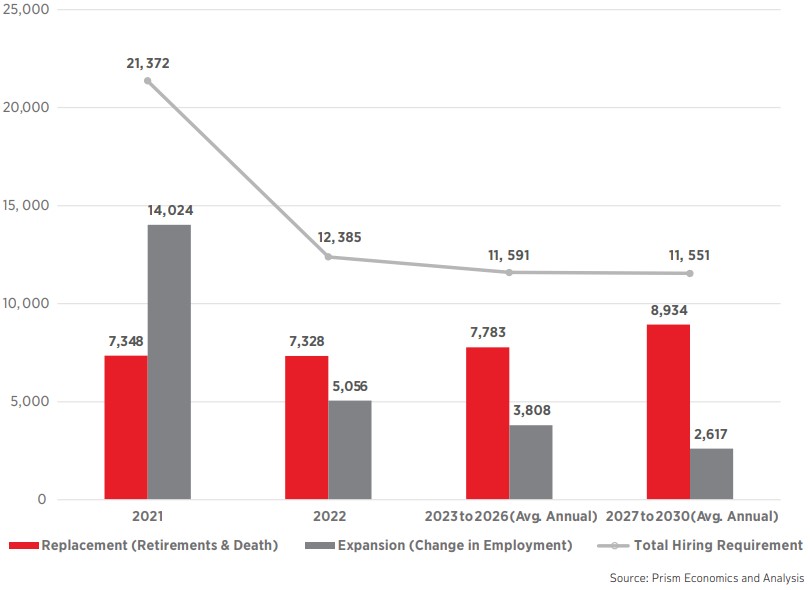
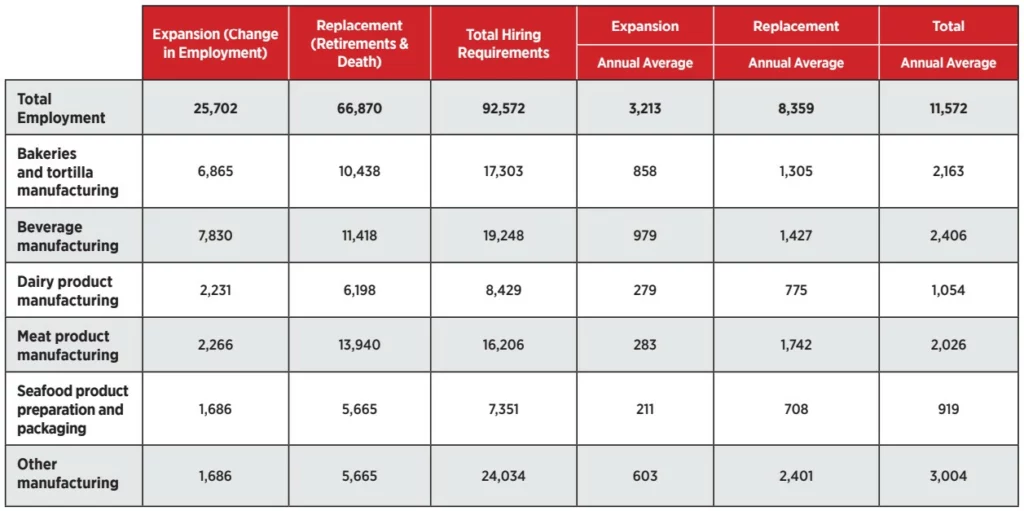
Economic growth is expected to slow to 0.7% in 2023, weighed down by a global reduction in spending. The annual growth rate is expected to average 2.1% between 2024 and 2030. The economy is anticipated to move back into an upward cycle in 2024, driven by lower levels of inflation, and improvements in global supply chains.

In 2022, the food and beverage processing industry contributed more than $35 billion in GDP. The industry accounts for 18% of the total manufacturing sector’s GDP and 2% of the National GDP. The largest contributors to GDP are beverage manufacturing, meat product manufacturing, other food manufacturing and bakeries and tortilla manufacturing. National GDP growth in the total manufacturing sector outpaced growth in the food and beverage sector in 2022.
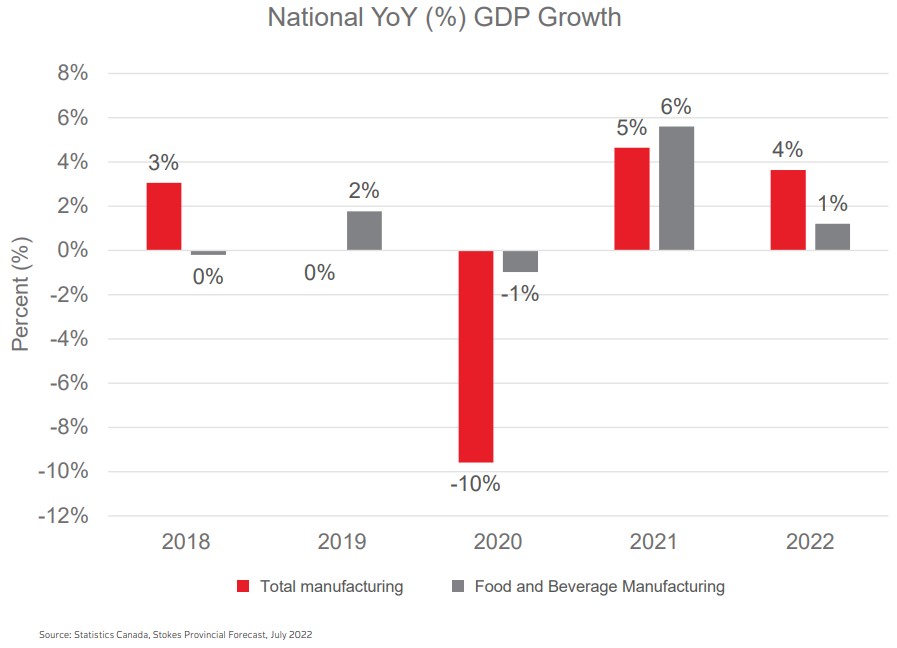
Canada’s is currently experiencing a decline in natural population growth (births minus deaths). Natural growth is anticipated to continue to decline in the coming years. Immigration will be the main driver of population growth over the next decade. Canada’s immigration target has increased from 300 thousand in 2016 to 500 thousand by 2025.
Based on these targets its assumed:

Food manufacturing sales (not including beverage) in 2021 saw the strongest YoY growth on record, followed by significant gains of approximately 12% in 2022. Canada’s food manufacturing industry has steadily increased its volume of trade in recent years. Food manufacturing exports grew significantly in 2022 (+14.3%), driven by increased demand for high-quality foods. As of 2022, the industry employed just over 250,000 workers. Food product manufacturing employment is expected to reach nearly 268,000 by 2030, an increase of 7% from 2022 employment. Inflation and increased labour costs and shortages were key challenges to the industry through the pandemic. Labour productivity increased in 2022, returning to the average rate observed prior to the pandemic.
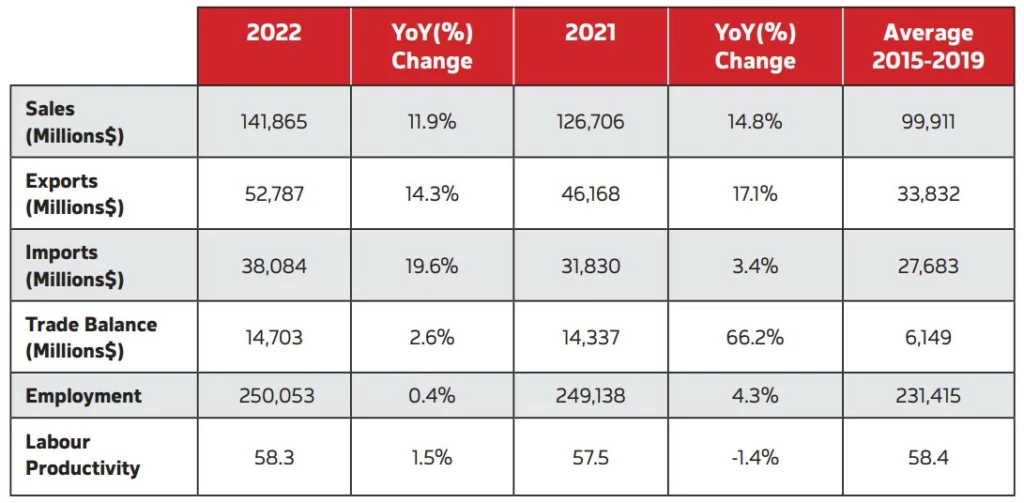
billion in sales
employed
establishments
of businesses have fewer than 100 employees
Beverage manufacturing sales saw a sharp decline in 2022, retreating to pre-pandemic levels. This decline was driven by decreased wine and liquor sales, following a significant ramp up in consumption in 2021. Canadian beverage exports in 2022 remained relatively unchanged from the export value in 2021 but was 7% higher than the value exported in 2019. As of 2022, the industry employed just under 50,000 workers. Beverage product manufacturing employment is expected to reach 57,000 by 2030, an increase of 16% from 2022 employment.
Export Value, 2022:
of the food and beverage workforce
Establishments, 2022:
GDP (in 2021):
Sales 2022:
Employment, 2022:
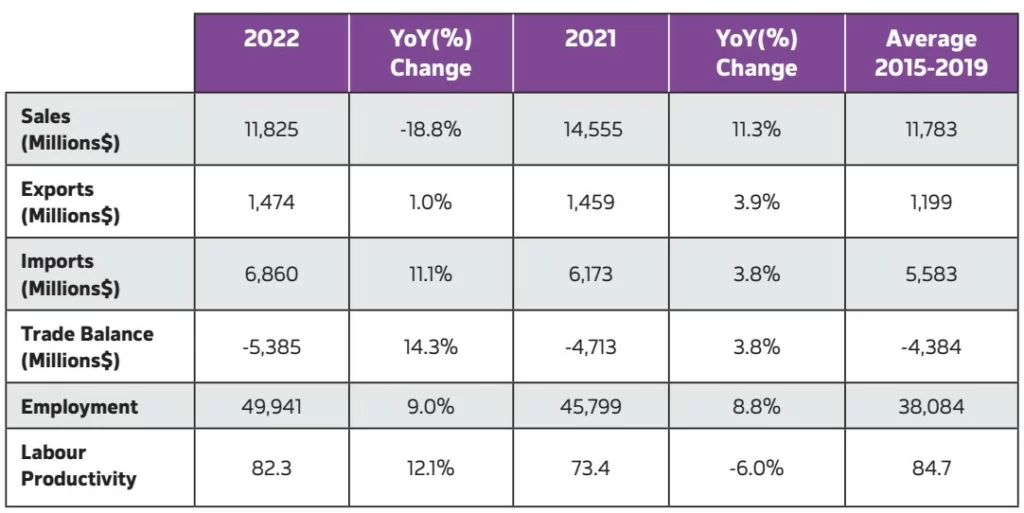
Canadian imports of dairy products have been consistently higher than exports. The value of exports has increased by 30% from 2019, while imports have risen by 39%, increasing the trade balance to $339 million in 2022. As of 2022, the sector employed approximately 27,500 workers. Dairy manufacturing employment is expected to reach 29,700 by 2030, an increase of 8% from 2022 employment. Increased input costs, driven by an increase in the farmgate price of milk components and higher feed costs, are likely to drive up prices of dairy products, which may shift consumer behaviour over the outlook period.
Export Value, 2022:
of the food and beverage workforce
Establishments, 2022:
GDP (in 2021):
Sales 2022:
Employment, 2022:
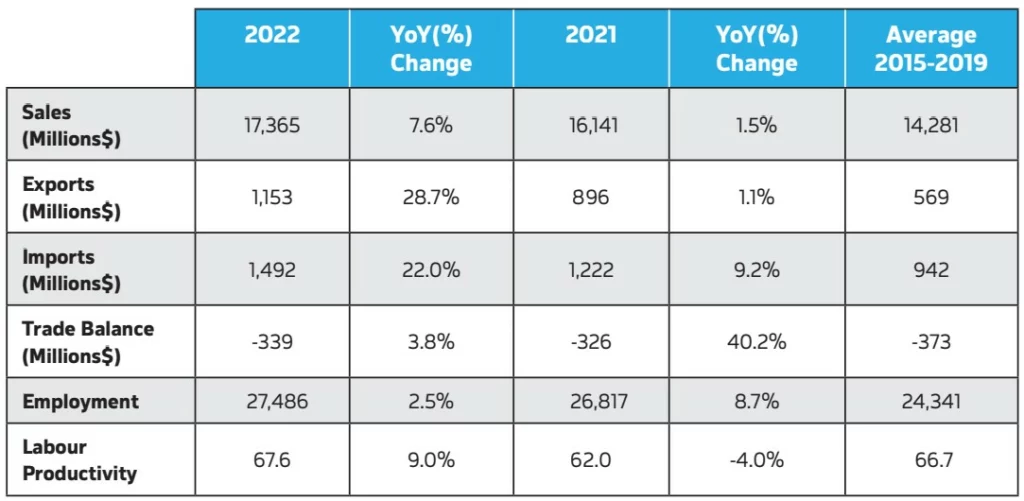
Survey results showed a shift toward plant-based meat alternatives, health and environmental concerns, and inflated cost have all contributed to a decrease in red-meat consumption in recent years. The value of meat exports reached $11.3 billion in 2022, a 3% increase from 2020 and an increase of 30% from 2019. Imports increased by 14% in 2022 and 34% from the 2019 value. As of 2022, the sector employed approximately 64,000 workers. Meat manufacturing employment is expected to reach 66,300 by 2030, an increase of 4% from 2022 employment. Labour productivity increased in 2022 but remained below productivity levels observed prior to the pandemic, as the industry was faced with heighted supply concerns and tight labour market conditions in 2022.
Export Value, 2022:
of the food and beverage workforce
Establishments, 2022:
GDP (in 2021):
Sales 2022:
Employment, 2022:
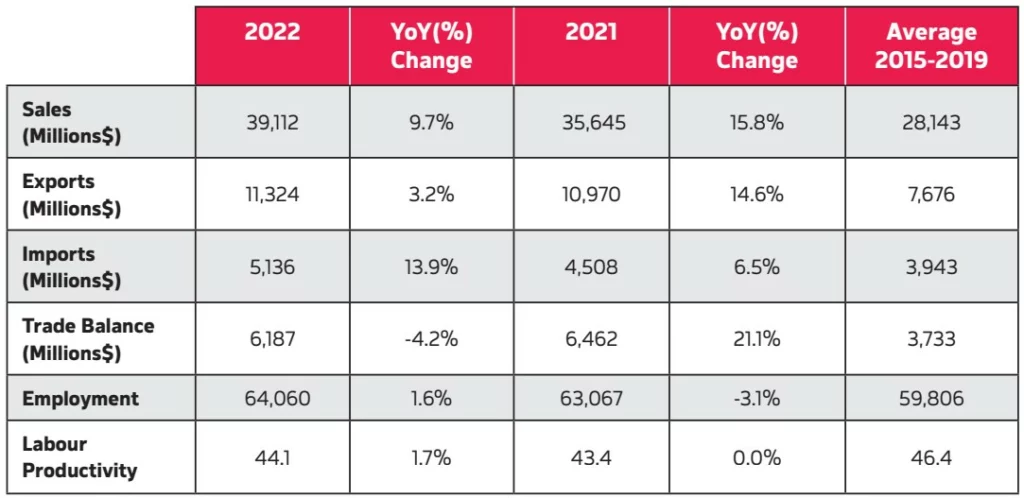
The consumption of freshwater fish is anticipated to rise steadily over the forecast period, as consumers explore meat-alternative protein sources. Following significant growth in 2021, seafood sales declined notably in 2022, moving back inline with the historic trend in sales. The closure of salmon farms in parts of BC negatively impacted sales in 2022 Canada’s seafood product exports were worth $5.5 billion in 2022, a 10% decline over 2021. Despite this decline, exports in 2022 were significantly higher than the average value prior to the pandemic. Total imports increased by nearly 20% in 2022 – a notable increase from the average value observed from 2015-2019. Increased domestic prices due to reduced supply of BC-grown-farm-raised-salmon forced grocers to turn to importing salmon from other countries.
Export Value, 2022:
of the food and beverage workforce
Establishments, 2022:
GDP (in 2021):
Sales 2022:
Employment, 2022:
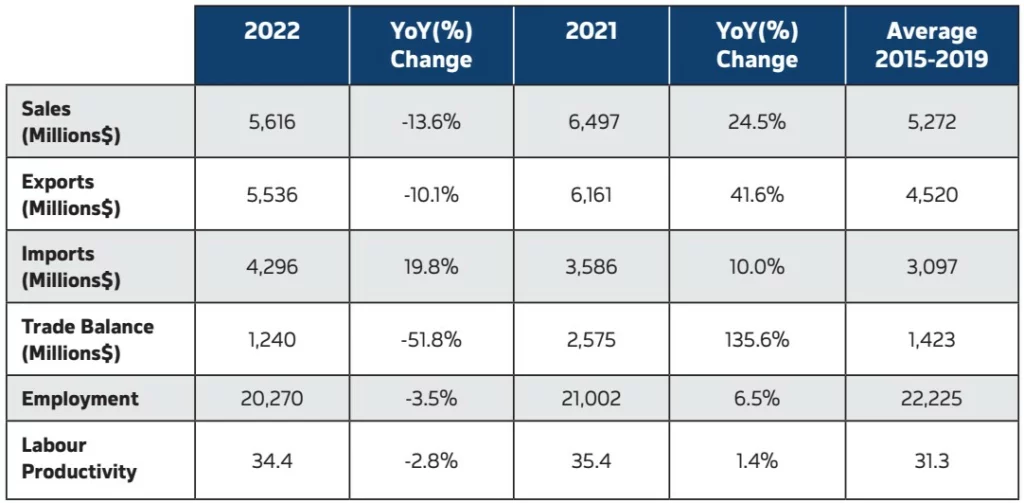
The consumption of freshwater fish is anticipated to rise steadily over the forecast period, as consumers explore meat-alternative protein sources. Following significant growth in 2021, seafood sales declined notably in 2022, moving back inline with the historic trend in sales. The closure of salmon farms in parts of BC negatively impacted sales in 2022 Canada’s seafood product exports were worth $5.5 billion in 2022, a 10% decline over 2021. Despite this decline, exports in 2022 were significantly higher than the average value prior to the pandemic. Total imports increased by nearly 20% in 2022 – a notable increase from the average value observed from 2015-2019. Increased domestic prices due to reduced supply of BC-grown-farm-raised-salmon forced grocers to turn to importing salmon from other countries.
Export Value, 2022:
of the food and beverage workforce
Establishments, 2022:
GDP (in 2021):
Sales 2022:
Employment, 2022:
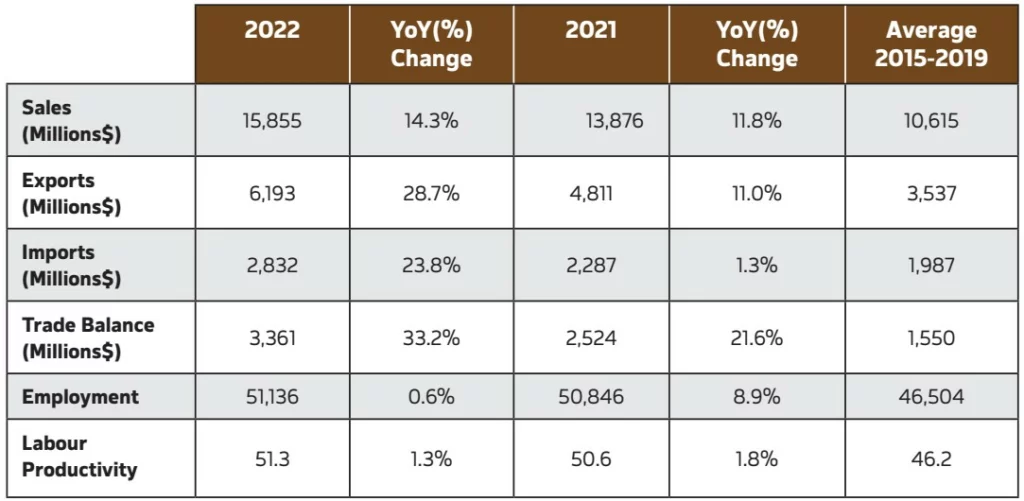
As of 2022, the food and beverage manufacturing sector employed approximately 300,000 workers. Industry employment is expected to reach 325,000 by 2030, an increase of 9% from 2022 employment. Total industry employment is anticipated to soften in 2023, following two years of rapid growth. Despite this easing, employment will remain above pre-pandemic levels. Following 2023, employment growth is anticipated to rise at an average annual rate of approximately 1% to 2030.
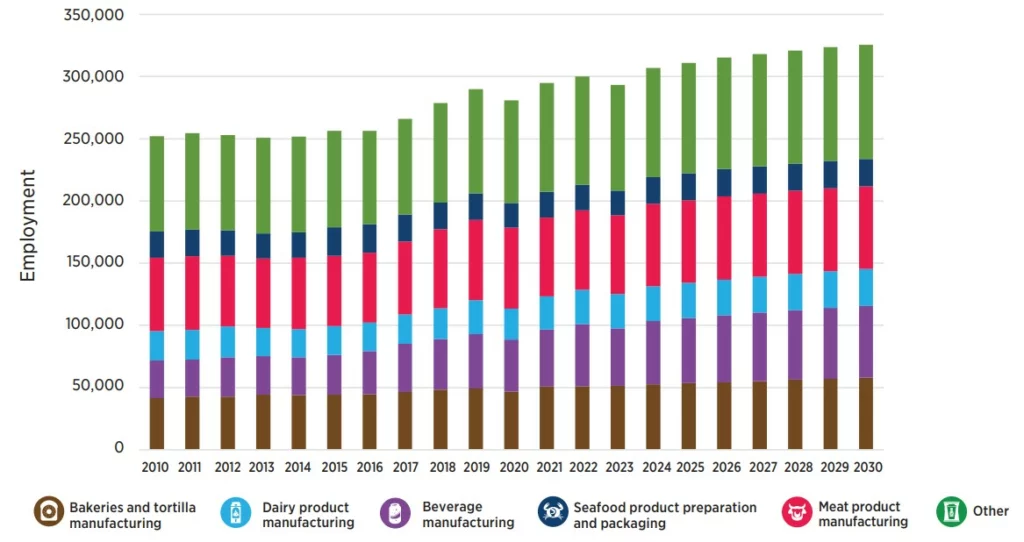
Beverage manufacturing is projected to lead industry growth over the outlook period, with employment increasing 16% between 2023 and 2030. Bakeries and tortilla manufacturing is also projected to see notable employment growth by 2030, stemming from increased consumption over the decade. Dairy and meat processing, segments which have seen a decline in consumption, are projected to see more modest growth over the same period.
